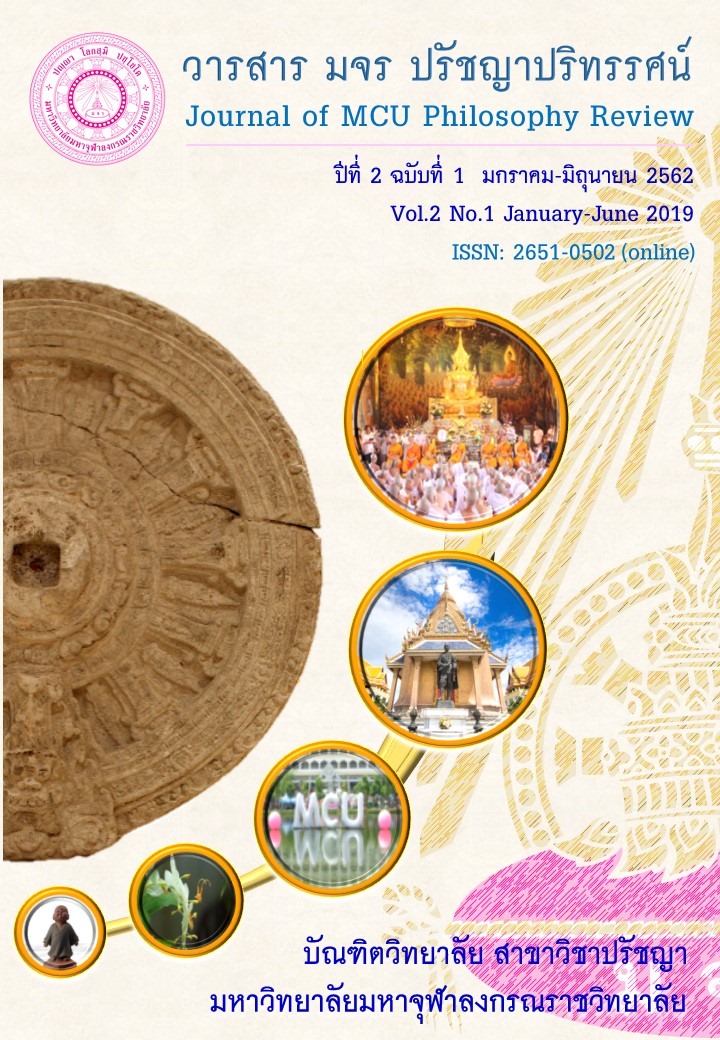THE ANUPUBBIKATHĀ FOR DEVELOPMENT OF QUALITY OF LIFE TO BUDDHISTS
Main Article Content
Abstract
This article aims at two main purposes (1) to study the Dhamma of Anupubbikathā 5 steps (2) to study using the Anupuphphiktha 5 steps for developing the quality of life of Buddhists. Using the five-step analysis, the five steps to improve the quality of life of Buddhists. The results of the study found that the Anupubbikathā is a very important preaching teachings that the Buddha taught the sermon is a 5-step order to clean the dispositions of human beings (human) to be thoroughly layers. (4) The erotic words that depict the sun are the blame of the erotic. (5) The words that depict the sun. Nokkham Mahasat the words that describe the virtues of the Sagittarius. Is out of erotic. The development of their quality of life according to the sequence in 5 steps of Anupubbikatha in their daily live. In the first step, they should give the materials, money, love, kindness or best wishes and forgive for everybody with every situation. Then it is to improve the quality of life for the step 2 is to maintain the 5 precepts, to improve the quality of life for the step 3 is enjoying of happiness in this world and happier with heaven in the future, as we know as there is paradise in heaven 6 floors, etc. When the need to improve the quality of life higher than step 3 to step 4, it is considered that the impermanence of erotic pleasure and can develop the mind to step 5 is exiting of erotic activities. Then they can pay mind to thriving at each degree. They can achieve happiness in life as well as the highest quality of life. This means Buddhists reach your goal. And the mind has to grow up and develop in a four Noble Truths and the results attained nirvana respectively.
Article Details
บทความที่ได้รับการตีพิมพ์เป็นลิขสิทธิ์ของวารสาร มจร ปรัชญาปริทรรศน์
ข้อความในบทความที่ได้รับการตีพิมพ์ในวารสาร ถือเป็นความรับผิดชอบของผู้เขียนบทความ และข้อคิดเห็นนั้นไม่ถือว่าเป็นทัศนะและความรับผิดชอบของกองบรรณาธิการวารสาร มจร ปรัชญาปริทรรศน์
References
พระธรรมวิสุทธิกวี (พิจิตร ฐิตวณฺโณ). (2547). อนุปพิกถาทีปนี ภาคที่ 1 ถึงภาคที่ 5. พิมพ์ครั้งที่ 6. กรุงเทพมหานคร: โรงพิมพ์มหามกุฏราชวิทยาลัย.
พระราชวรมุนี (ป.อ.ปยุตโต). (2527). ทางสายกลางของการศึกษาไทย. พิมพ์ครั้งที่ 2.กรุงเทพมหานคร :คณะศึกษาศาสตร์ มหาวิทยาลัยเกษตรศาสตร์.
พระพรหมคุณาภรณ์ (ป.อ.ปยุตโต). (2549). ลักษณะแห่งพระพุทธศาสนา. กรุงเทพมหานคร : พิมพ์สวย.
พระพรหมคุณาภรณ์ (ป.อ.ปยุตโต). (2554). ความสุขทุกแง่ทุกมุม. พิมพ์ครั้งที่ 2.กรุงเทพมหานคร : สำนักพิมพ์ผลิธัมม์
พระมหาสมชาย สิริจนฺโท. (2547). พุทธธรรมเพื่อการพัฒนาคุณภาพชีวิตตามแนวทางของ
พระเทพวรคุณ (สมาน สุเมโธ). วิทยานิพนธ์พุทธศาสตตรมหาบัณฑิต.บัณฑิตวิทยาลัย มหาวิทยาลัยมหาจุฬาลงกรณราชวิทยาลัย.
สมิต อาชวนิจกุล. (2544). พัฒนาแนวทางก้าวหน้าแนวทางปรับปรุงตนเองสู่ความสำเร็จ.กรุงเทพมหานคร: นวสารินการพิมพ์.
มหาจุฬาลงกรณราชวิทยาลัย. (2539). พระไตรปิฏกภาษาไทย.ฉบับมหาจุฬาลงกรณราชวิทยาลัย. กรุงเทพมหานคร : โรงพิมพ์มหาจุฬาลงกรณราชวิทยาลัย.
ราชบัณฑิตยสถาน. (2526). พจนานุกรมฉบับราชบัณฑิตยสถาน.พ.ศ.2525. พิมพ์ครั้งที่ 6. กรุงเทพมหานคร: อักษรเจริญทัศน์.
พระสมชาย สิริจนฺโท. (2527). “พุทธรรมเพื่อการพัฒนาคุณภาพชีวิตตามแนวทางของพระเทพวรคุณ (สมาน สุเมโธ)”. วิทยานิพนธ์พุทธศาสตรมหาบัณฑิต. บัณฑิตวิทยาลัย มหาวิทยาลัยมหาจุฬาลงกรณราชวิทยาลัย
เสถียร โพธินันทะ. (2535). ประวัติศาสตร์พระพุทธศาสนาฉบับมุขปาฐะ. กรุงเทพมหานคร :มหามกุฏราชวิทยาลัย.


